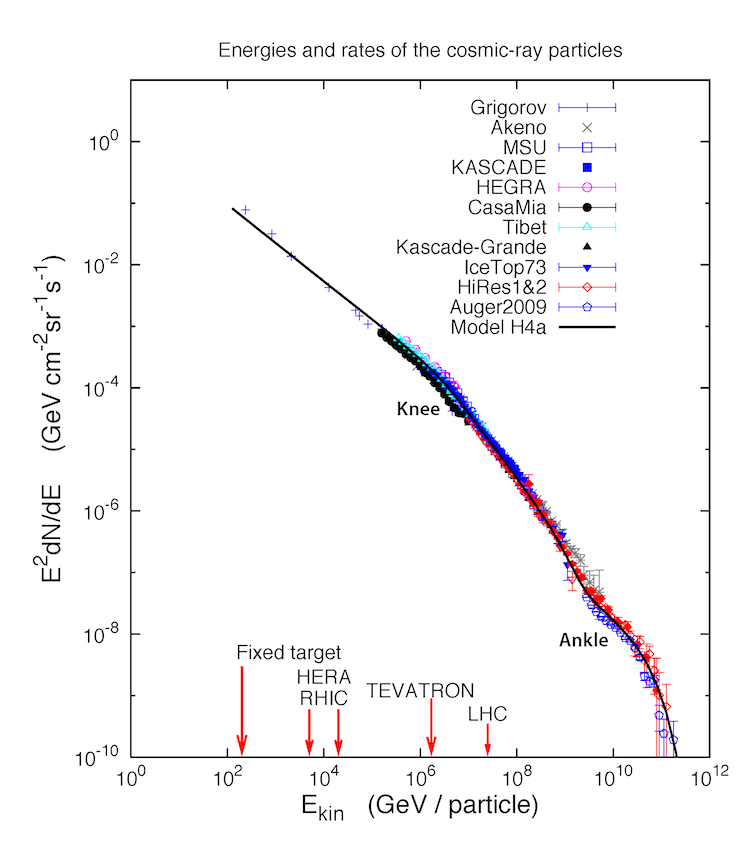Science
People have always been curious about the celestial objects surrounding us—the stars, the planets, and the galaxies that make up the cosmos. The phenomena and objects outside of the Earth's atmosphere have been observed for centuries, first by eye and then by telescopes. "Classical" astronomy has always used visible light (photons), and since the mid-20th century has used other frequencies of electromagnetic radiation: photons of higher energy (such as x-rays and gamma rays) and lower energy (such as radio waves). Neutrinos give us a different, new, and exciting way to look deep into astrophysical objects.
The GZK neutrinos that are the primary science aim of the ARA detector are cosmogenic neutrinos inevitably produced by the highest energy cosmic rays. These cosmic rays, a century-old problem, are charged nuclei from space coming from unknown astrophysical sources. Looking at neutrinos, particles that are not bent in magnetic fields, provides a different way to potentially uncover the source of cosmic rays.
Background
Until recently, high-energy particle physics research has been dominated by collider physics. As costs associated with the construction of increasingly powerful colliders has grown, attention has turned to “natural” accelerators capable of attaining particle energies 10 million times higher than terrestrial colliders. The detection of such cosmic ray particles at the Earth’s surface then provides information on those celestial accelerators and brings particle physics to the energy frontier.
Understanding the origins of cosmic rays has been a challenge since their discovery by Victor Hess nearly a century ago. It is now thought that most cosmic rays are ordinary nuclei accelerated to high energies in dynamic electric and magnetic fields associated with supernova explosions in our galaxy; however, this explanation is not sufficient to account for the highest energy particles, which now observationally exceed 10^20 eV.
Although ultrahigh-energy cosmic rays (UHECR) likely originate throughout the Universe, those observed at Earth must be produced locally since such UHECR lose energy while propagating through the CMB ( , etc.). This process (discussed by Greisen and Zatsepin and Kuzmin - GZK) not only causes energy loss for the primary particle, but creates secondary particles of extremely high energy. It is these secondary particles, particularly UHE neutrinos, which may be used to test models of the origins of UHECR. With no electric charge, neutrinos experience no scattering or energy loss, and so provide an appropriate probe of the GZK source distribution even to high redshift. Since UHECR have been observed, the GZK neutrino flux models have a solid basis, although extrapolation of source models to higher redshift introduces some uncertainty. Thus, while UHECR tell us about the recent Universe, UHE neutrino detection will provide crucial information at higher redshifts of
=1-4, during the epoch of structure formation. In addition to the “guaranteed” GZK neutrinos, it is likely that the sources of UHECR will produce neutrinos directly. For example, production of UHECR may entail
-acceleration followed by
, with subsequent escape of the neutron; ensuing weak decays must also produce neutrinos. Cosmological relics may also decay or annihilate to produce a subdominant UHE neutrino flux.
Estimated event rates depend not just on the neutrino flux, but also on the neutrino-nucleon cross section in a region beyond the reach of accelerator experiments. The ARA detector is sized based on calculated Standard Model cross sections. With sufficient statistics, these predictions can be tested by determining the differential event rate near the horizon. An extreme possibility would be to discover significantly enhanced cross sections, such as those that occur in fundamental theories with extra dimensions.
The detection of GZK neutrinos is an experimental challenge at the frontier of neutrino astronomy, which has progressed over the last half century from initial detections of low-energy thermal neutrinos from our sun, to detection of modest-energy neutrinos produced by cosmic ray interactions in the Earth's atmosphere, to the current successful efforts of the IceCube and Antares collaborations to detect higher energy neutrinos from sources outside our solar system. With each increase in neutrino energy, the required detector increases in size to compensate for the dramatic decrease in flux with energy. At one cubic kilometer, the IceCube observatory is still too small to detect GZK neutrinos with a reasonable rate, and the technology is too costly to scale up to the 100 or more cubic kilometers envisioned here. With the primary goal of discovering GZK neutrinos and establishing the spectrum, the proposed ARA radio receiver array is necessarily sparse. We maintain energy sensitivity down to ~eV by adopting a modular ”station” design. Based on data taken by our initial testbed station in 2011, we estimate the angular resolution for the reconstructed direction of the incoming neutrino at
. At high redshift (
), GZK neutrinos are produced within 6 Mpc (
) of the associated UHECR source. Our proposed instrument is not likely to perform classical neutrino astronomy, but the energy resolution (dominated by intrinsic electroweak physics rather than detector systematics) is sufficient to enable measurement of neutrino-nucleon cross sections, and the sky distribution of events will verify basic operation of the detector and identify the source events as cosmic neutrinos.

